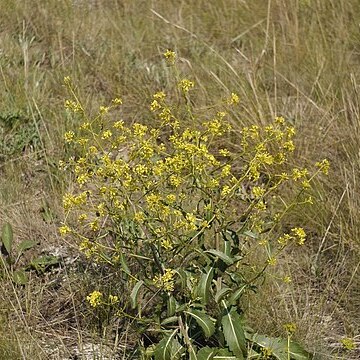Herbs biennial or perennial, (40-)50-100(-130) cm tall, basally hirsute or rarely glabrous. Stems erect, branched basally and above. Basal and lowermost cauline leaves long petiolate; leaf blade oblanceolate, elliptic, oblong-ovate, or oblong-linear, (3-)5-14(-20) × (0.5-)1-3.5(-6) cm, base cuneate or attenuate, margin dentate, repand, or entire. Upper cauline leaves petiolate or subsessile, linear, oblanceolate-linear, lanceolate, or oblong, to 8 cm, base attenuate or cuneate, margin entire or dentate. Fruiting pedicels divaricate, (0.6-)0.8-1.8 cm. Sepals oblong, 3-4(-4.5) × 1-1.5 mm, erect or rarely ascending. Petals yellow, (5-)6-8.5(-10) × 2.5-3.5(-4) mm, obovate, apex rounded; claw 2.5-4 cm. Filaments 3.5-4.5 mm; anthers ovate, 1-1.5 mm. Fruit linear, (1.5-)2-4(-4.8) cm × (1-)1.5-2 mm, terete or slightly flattened, borne on a gynophore (0.8-)1.5-4(-5) mm, divaricate; valvular segment (1.2-)1.6-4(-4.5) cm, (2-)5-11(-13)-seeded per locule; valves with a prominent midvein, torulose; terminal segment linear, stylelike, (0.5-)1-2.5(-3) mm, seedless. Seeds brown or grayish, globose, 1-1.5 mm in diam., minutely reticulate. Fl. and fr. Jun-Aug. 2n = 22.
Biennial or perennial herb, erect, to 1 m tall, branched. Leaves fleshy, glaucous; basal leaves petiolate, elliptic in outline, sinuate or shallow-pinnatifid, densely hispid, bristles curved; upper leaves diminishing, lanceolate, narrowing to base. Inflorescence elongating from concave corymb. Sepals more or less erect, 3–5 mm long. Petals 6–10 mm long, pale yellow. Ovary on gynophore 0.5–4 mm long. Siliqua 1–2 (occasionally to 4) cm long, 1.5–2.5 mm wide, terete to quadrangular, obliquely erect; beak 0.5–2 mm long, tapering, seedless. Seeds 6–8 per locule, 1–1.5 mm wide, dark grey to brown.
A cabbage family herb. It grows for 2 or several years. It grows 50-100 cm tall. The stems are erect and branched. The lower leaves have long leaf stalks. They are oblong or sword shaped. They are 8 cm long.


